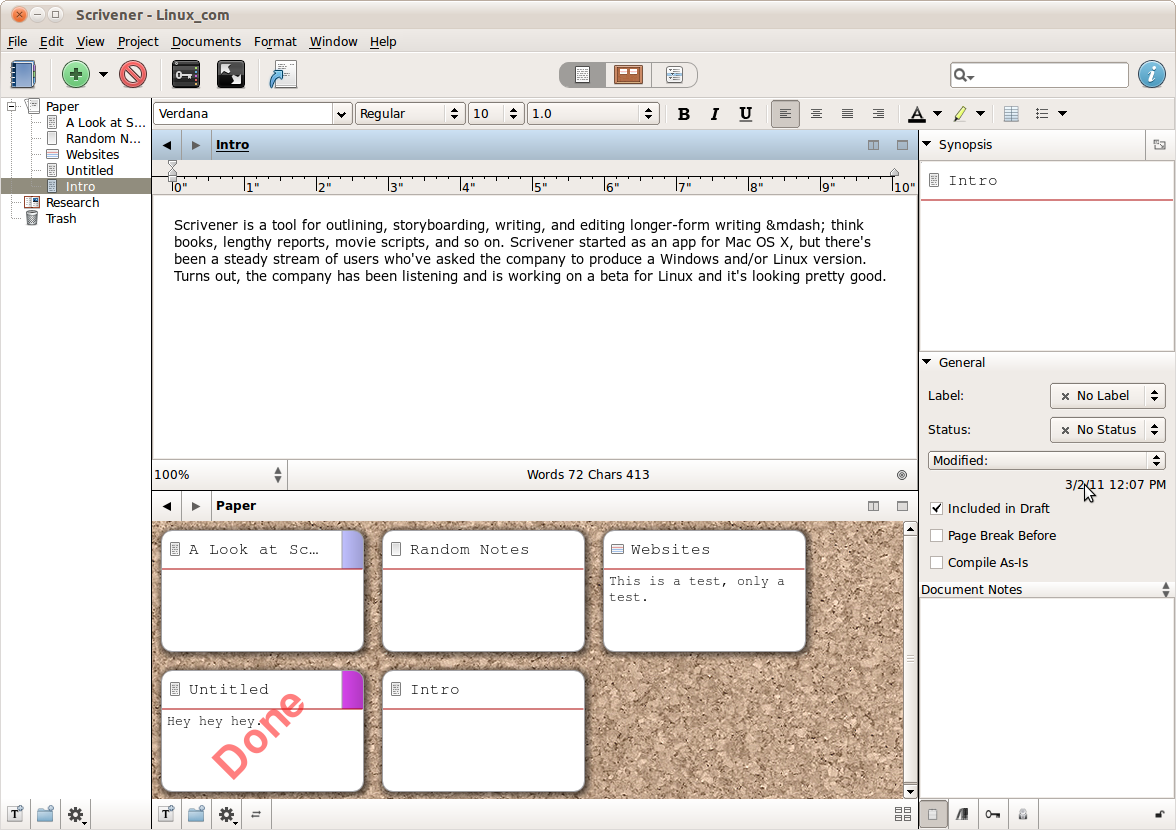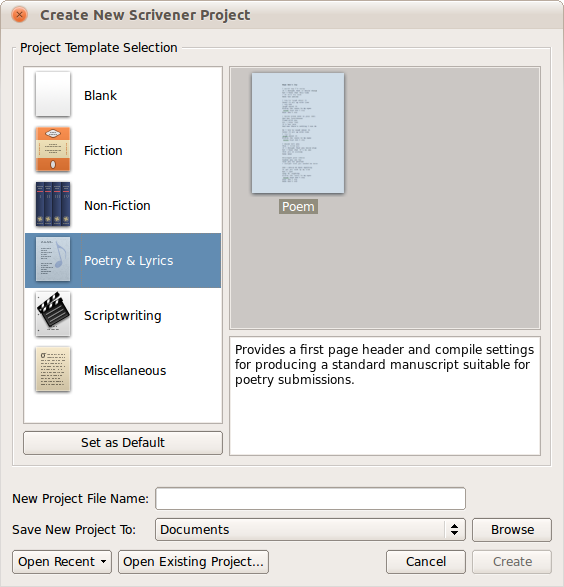Scrivener is a tool for outlining, storyboarding, writing, and editing longer-form writing — think books, lengthy reports, movie scripts, and so on. Scrivener started as an app for Mac OS X, but there’s been a steady stream of users who’ve asked the company to produce a Windows and/or Linux version. Turns out, the company has been listening and is working on a beta for Linux and it’s looking pretty good.
Scrivener has been on my radar for a few years as an example of the application gap between Linux and other desktop platforms. Even though it’s not yet ready for prime time, I thought it’d be worth looking at now. For one thing, I’d like to drive awareness of the Linux beta to help give feedback to the company and support companies that are targeting the Linux desktop. Second, Scrivener might help more users decide to make the switch from Mac or Windows to Linux — if writing is the primary use of a computer, Scrivener may tip the balance in favor of Linux.
If you’re feeling adventurous and want to follow along, the betas are available under the “Scrivener for Windows” section. This includes some videos of the Windows version, and the company doesn’t talk much about the Linux beta. Perhaps a bit of additional attention will help that along. Note that the betas are time-limited, so you’ll have to download a new beta every few weeks (depending on when you get started). The current beta is set to expire on March 21.
Using Scrivener
Scrivener for Linux is provided as a gzipped tarball. I tried it on Ubuntu 10.10, and it should work on most Linux distros. The instructions for installing Scrivener for Linux are on the wiki. You’ll notice that the Linux version doesn’t get as much attention as the Windows release that’s in development.
Given that the Linux development was sort of off in the corner, I was a bit concerned that Scrivener for Linux would reflect that and be half-baked. This, I’m happy to say, doesn’t seem to be the case. While I haven’t written a whole novel or tackled a massive project with Scrivener on Linux, I banged on it enough that I’m satisfied it’s worth a look by other users.
You start with a new project. Note that it’s a new project and not file. The concept with Scrivener is that you’re working on something fairly meaty that will be in process for a long time.
Scrivener has three “views” — document, outline, and corkboard. It’s the corkboard view that first grabbed my attention because it gives a different way to organize pre-writing materials.
 Even though I do all my writing on the computer, I tend to use paper and pen to scribble ideas and outlines for longer projects. When I was writing really long papers in college, I’d use index cards, sticky notes, and/or legal pads to get organized before sitting down to write so I could arrange and re-arrange main ideas and keep quotes and such handy. Scrivener’s corkboard view lets you achieve something similar on the computer, without the need to fell trees.
Even though I do all my writing on the computer, I tend to use paper and pen to scribble ideas and outlines for longer projects. When I was writing really long papers in college, I’d use index cards, sticky notes, and/or legal pads to get organized before sitting down to write so I could arrange and re-arrange main ideas and keep quotes and such handy. Scrivener’s corkboard view lets you achieve something similar on the computer, without the need to fell trees.
You start with a main project, and then can keep multiple text files under the project that hold bits of information or writing. Scrivener comes with several templates that help get you started depending on what type of project that you’re interested in working on. For instance, if you want to write a play or book, Scrivener has templates that correspond with that.
Let’s say you want to write a book, and need to keep all the characters and major plot points straight. You create folders for plot points and characters in the “binder” on the left-hand side of the interface. Each character or plot point can have its own text file. Using the corkboard interface, you can arrange, label, and set a status for each item.
The same features can be used to organize acts in a play, chapters in a book, etc. Scrivener also gives a “status” tag for items, so you can tag things “in process,” “first draft,” “final draft,” “done,” or whatever status might apply for your work. For instance, if you were using Scrivener for investigative journalism (does anyone do that any more, or do they just follow Charlie Sheen?) you might use the interface to keep notes straight from each source and use the status to follow the process from drafting a story to fact-checking.
It is worth noting that Scrivener is mostly a solitary tool. It doesn’t seem to have any collaboration features per se. It does support importing text files, so you could use another editor to do most of your writing and then use Scrivener to organize your writing. But it doesn’t support ODF or Word document import, so it may not be a great fit for writers who’ve got a huge investment in those tools.
Scrivener basically provides a very lightweight framework for an author to impose their on structure on the writing process. It also has some neat tools like a name generator, which might be useful for fiction writers who have trouble with names. Naturally it also has tools for tracking document statistics (read: word count) which is an inexplicable oversight in all too many tools.
It’s worth noting that Scrivener is highly customizable and has some nice miscellaneous features that will appeal to many writers. Don’t like the “look” of the index cards in the Scrivener interface? No problem, you can tweak the colors of their lines, backgrounds, etc. You also have “typewriter scrolling” so that you can keep your eyes on the middle of the page while writing (if you choose to enable it).
When, or if perhaps, you finish the Great American Novel then you can export into PDF, RTF, HTML, and other formats. Note that “Word” is not one of those formats — though RTF will usually pass for Word, at least initially. Nor is ODF supported by Scrivener.
Final Thoughts
So is Scrivener a silver bullet for productive writing? Scrivener isn’t for everybody, or for lightweight projects. If you just need to produce a short paper, story, or blog post then it’s not really worth learning to use Scrivener.
But is it worth it if you are doing longer-form writing? It’s a definite maybe. Scrivener is an acquired taste, and it may or may not be a good fit for your style of working. The only way to really find out is to try it on a project or two. I’m still poking around and trying to decide if the features in Scrivener are worth passing on 12 years of experience with Vim. More than likely, no — but the fact that it’s even a consideration indicates that Scrivener has some nifty features.
To be clear, no tool is going to “make you a better writer.” But a good tool may help you be more productive and make writing more pleasant. A bad tool can certainly be a hindrance.
Since the beta is free (and I believe that they’ll have a trial period once it’s released), I’d suggest giving Scrivener a spin when you have a project that you can afford to tinker with for a bit. I suspect Scrivener will only appeal to a minority of writers, but those who find it appealing will really love it. You’ll only know if you’re one of those writers if you give it a spin.






